My program is a CRM, I used Rad Ribbon Bar, so Many Buttons with images, RadGridView (which some columns contain images) and so many other controls which contain images. It's a mdi parent/child program.
In so many cases while loading a mdi child or working with some grid views the program will hang and give me this error:
OutOfMemoryException occurred in System.Drawing.dll
I tried GC.Collect() on certain parts but no success. For setting images there is no code! for example for setting an image for a button I used its properties in visual studio. I have set All other control images in this way using the properties panel in visual mode.
and These are some designer codes related to drawing:
btnCustomerList.Image = global::MyApp.Properties.Resources.CustomerList32;
gridViewCommandColumn1.Image = global::MyApp.Properties.Resources.ViewShop32;
and When The error comes after a while working with the app, it will appear in Program.cs and in the line Application.Run(new MainForm());:
static void Main()
{
AppDomain.CurrentDomain.SetData("APP_CONFIG_FILE", AppDomain.CurrentDomain.BaseDirectory + "\\Settings.config");
bool ok;
Mutex m = new Mutex(true, WindowsIdentity.GetCurrent().Name.ToString().Split('\\')[1] + "MyApp", out ok);
if (ok)
{
Application.EnableVisualStyles();
Application.SetCompatibleTextRenderingDefault(false);
// The Error will cause HERE
Application.Run(new MainForm());
GC.KeepAlive(m);
}
else
Application.Exit();
}
MainForm is the mdi parent which contains Ribbon Bar.
and this is the Full stack trace:
at System.Drawing.Image.FromHbitmap(IntPtr hbitmap, IntPtr hpalette)
at System.Drawing.Image.FromHbitmap(IntPtr hbitmap)
at System.Drawing.Icon.ToBitmap()
at System.Windows.Forms.ThreadExceptionDialog..ctor(Exception t)
at System.Windows.Forms.Application.ThreadContext.OnThreadException(Exception t)
at System.Windows.Forms.Control.WndProcException(Exception e)
at System.Windows.Forms.Control.ControlNativeWindow.OnThreadException(Exception e)
at System.Windows.Forms.NativeWindow.Callback(IntPtr hWnd, Int32 msg, IntPtr wparam, IntPtr lparam)
at System.Windows.Forms.UnsafeNativeMethods.DispatchMessageW(MSG& msg)
at System.Windows.Forms.Application.ComponentManager.System.Windows.Forms.UnsafeNativeMethods.IMsoComponentManager.FPushMessageLoop(IntPtr dwComponentID, Int32 reason, Int32 pvLoopData)
at System.Windows.Forms.Application.ThreadContext.RunMessageLoopInner(Int32 reason, ApplicationContext context)
at System.Windows.Forms.Application.ThreadContext.RunMessageLoop(Int32 reason, ApplicationContext context)
at System.Windows.Forms.Application.Run(Form mainForm)
at MyApp.Program.Main() in d:\\MyApp\\Application\\MyApp\\Program.cs:line 36"
UPADTED:
the code for calling mdi-children by clicking on ribbon bar buttons is here:
private void btnCustomerList_Click(object sender, EventArgs e)
{
OpenForm(new FormCustomerList(), "Customer List");
}
private void btnCustomerRelated_Click(object sender, EventArgs e)
{
OpenForm(new FormCustomerRelated(), "Customer Related");
}
and Here is OpenForm method:
private void OpenForm(Form formType, string Caption)
{
foreach (Form nform in Application.OpenForms)
{
if (nform.GetType() == formType.GetType())
{
nform.Activate();
return;
}
}
this.MdiChildren.OfType<Form>().ToList().ForEach(x => x.Dispose());
GC.Collect();
Form form = formType;
form.MdiParent = this;
form.Dock = DockStyle.Fill;
form.Show();
this.Text = Caption;
}
and in every mdi child's form constructor, after InitializeComponent(); I wrote GC.Collect(); also. But as told in comments, the GDI objects in task manager will increase and increase till 10000 objects and then application will crash.
UPADTED: THE MOST ISSUE
It seems I have found the part which cause the most GDI objects. In every form there are some controls like textboxes, drop down list etc. I have set some rules for them, for example if user enter a textbox, its back color should be yellow and after leave it should be white again. So there is a main method which I call in form load to literate through all controls and find the target ones and add for example enter and leave events with the defined rules. something Like This:
private void FormCustomerList_Load(object sender, EventArgs e)
{
ClassCRMControls.AddEventHandler(this);
}
and inside ClassCRMControls class:
public static void AddEventHandler(Control parent)
{
foreach (Control c in parent.Controls)
{
if (c.GetType() == typeof(RadTextBox))
{
c.Enter += new EventHandler(ClassCRMControls.EnterEvent);
c.Leave += new EventHandler(ClassCRMControls.LeaveEvent);
}
else
AddEventHandler(c);
}
}
private static void EnterEvent(object sender, EventArgs e)
{
(sender as RadTextBox).TextBoxElement.TextBoxItem.BackColor = Color.FromArgb(255, 251, 147);
}
private static void LeaveEvent(object sender, EventArgs e)
{
(sender as RadTextBox).TextBoxElement.TextBoxItem.ResetValue(LightVisualElement.BackColorProperty, ValueResetFlags.Local);
}


